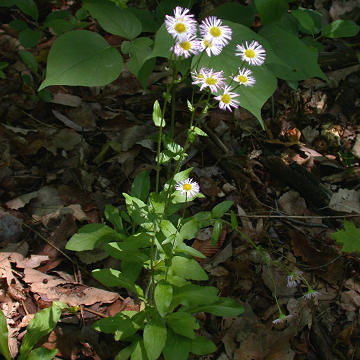

Erigeron philadelphicus - (image 1 of 5)
Taxonomy
Family: Asteraceae
Habitat
Moist meadows, dry prairies, occasionally in lawns, loose turf, or other disturbed open areas.
Associates
In dry prairies with Allium canadense, Andropogon scoparius, Comandra umbellata, Heuchera richardsonii, Liatris aspera, Phlox pilosa fulgida, Poa pratensis, Silphium integrifolium, Tradescantia ohiensis. In low lying meadows with Carex stricta, Carex vulpinoidae, Equistium arvense, Galium obtusum, Helenium autumnale, Hypoxis hirsuta, Juncus dudleyi, Lathyrus palustris, Lycopus americanus, Lythrum alatum, Oxypolis rigidior, Senecio pauperculus, Sisyrinchium albidum, Zizia aurea.
Distribution
Widespread.
Morphology
Herbaceous biennial or short-lived perennial to 70 cm, pubescent with long, spreading hairs to subglabrous. Leaves simple, few to several, narrowly lanceolate or oblong to ovate; stem leaves broadly rounded to sessile or more of less auriculate-clasping bases. Flowers: involucres with phyllaries in one series, all of them nearly or quite the same length. Ligules about 100, linear-filiform; rays white to pink; disk bright yellow; heads less than 2.5 cm across.
Notes
Flowers early May to late July
Wetland indicator: Facultative Wetland
Not sure as to the origin of the name "fleabane". It could have been inspired by the resemblance of the seeds to fleas or it could be that another plant by that name, in a different genus, is purported to be a flea repellent.
References
Gleason, Henry A.
and A. Cronquist. 1991. Manual of Vascular Plants of Northeastern United States
and Adjacent Canada. Second Ed.
The New York Botanical Garden. Bronx, NY
Swink, F. and G. Wilhelm. 1994. Plants of the Chicago Region.
Indiana Academy of Science. The Morton Arboretum. Lisle, Illinois.
|
Michael Hough © 2004 |